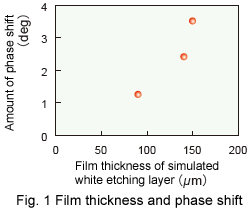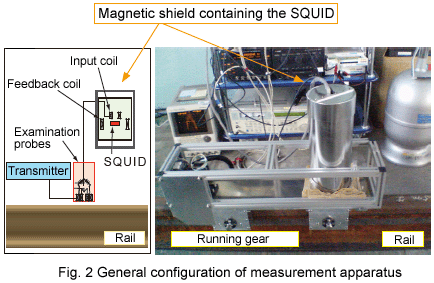A hard and brittle heat transformation structure called a white etching layer may be generated on rail surfaces due to wheel sliding and wheel slip during braking. The presence of this layer may cause fine cracks in the interior and the surrounding area, and the continued use of rails while these cracks are present would lead to rail damage such as shelling. To detect white etching layers, hardness measurement and visual observation are performed on the spot, but no technique for continuous inspection is currently available. Accordingly, the RTRI focused on differences in the electromagnetic characteristics between normal rail materials and white etching layers, and developed an apparatus to detect such layers using a SQUID (Superconducting Quantum Interference Device). In the field use of SQUIDs, which are high sensitivity magnetic sensors, it is especially important to remove magnetic noise such as remanent magnetization. For the apparatus used here, we adopted a method to amplify a very faint signal from an eddy current examination probe using the SQUID. Since the device itself can be completely stored within a small magnetic shield in this method, the system is resistant to the influences of geomagnetic fields and magnetic noise from rails. When an AC magnetic field is applied from the examination probe to a rail, eddy currents generated on the rail generate an induction field. The RTRI focuses on the phase shift of the induction field generated depending on the film thickness of the white etching layer (Fig. 1), and evaluates the film thickness of the layer through comparison with theoretical analyzed values.
The Institute fabricated automotive measurement apparatus with the developed equipment on board, thus enabling continuous inspection of the tread surface of rail (Fig. 2). Since the apparatus can continuously monitor the status of white etching layers in this part, it can be used for early diagnosis of rails in the preliminary steps leading to cracks. The RTRI is planning to downsize the related peripheral equipment so that the field measurement can be performed.
|



